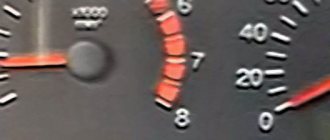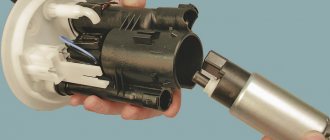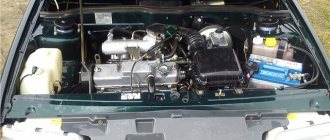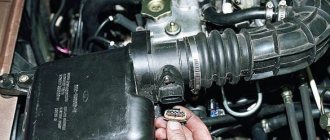Why does the car hold 2000 rpm VAZ 2114 injector 8 valves
- To the beginning of the forum
- Forum Rules
- Old design
- FAQ
- Search
- Users
Check the connector of the coolant temperature sensor, if there is water there, then remove it and you can spray it with an HP-shkoy.
This happened to me recently after washing the engine. Check the connector of the coolant temperature sensor, if there is water there, then remove it and you can spray it with an HP-shkoy. This happened to me recently after washing the engine.
Thanks, I'll try it, by the way, it looks like it. Yesterday we had a downpour and after driving at this time the revs rose.
and also, please, where is this sensor located, you can reach it.
it is necessary to stretch the ground; this happens when the fan turns on or the IAC simply jams
TPS (throttle position sensor) - try a new one (working one, for example, from a friend’s car
). You can test it (measure the resistance), but IMHO it’s better to buy a new one (about 250 rubles), as a last resort, if yours is normal, you’ll have a spare one.
Check the connector of the coolant temperature sensor, if there is water there, then remove it and you can spray it with an HP-shkoy. This happened to me recently after washing the engine.
Thanks, I'll try it, by the way, it looks like it. Yesterday we had a downpour and after driving at this time the revs rose.
and also, please, where is this sensor located, you can reach it.
The coolant temperature sensor is located to the left of the engine in the direction of travel, between the engine and the thermostat. The connector is 2-pin, facing up.
How is the water in this connector connected to the lies of the TPS - HZ
But I still had this problem
Source
Methods for eliminating floating engine speeds
When starting to find and eliminate the reasons that cause unstable operation of the engine in idle mode, you first need to check:
- Condition of the air filter and spark plugs. If they become critically dirty, they need to be replaced.
- Integrity of insulation of high-voltage wires. If damage is found, they must be replaced.
It is recommended to make sure that there is no suction at the junction of the intake manifold with the engine cylinders. To do this, with the engine running, you need to sequentially spray all joints at the joints with carburetor cleaner or other flammable liquid. If atmospheric air enters there, the car engine jerks sharply, which is why, if a damaged gasket or plug is detected, the element is replaced.
Checking the tightness of the intake manifold (video guide)
Let's consider the remaining elements of the car, the malfunction of which can affect the smooth operation of the VAZ 2114 engine in idle mode.
Solenoid valve diagnostics
Cars with engines equipped with a carburetor are equipped with idle speed solenoid valves. Devices are checked as follows:
- Disconnect the power cord.
- Start the engine to warm up.
- Connect the wire. If a clear click is not heard, the part must be replaced.
Attention! To fully ensure that the valve is working properly, be sure to clean the nozzle and repeat the test.
Adjusting the idle speed on a carburetor engine (with video)
Note that the main reason for the appearance of floating idle speed in engines of this type is the incorrect operation of the carburetor. The device is adjusted by rotating the fuel quality and quantity screws.
The main reasons for high speed
As a rule, high speeds of the VAZ 2114 are caused by one of the following malfunctions:
- the air filter is clogged;
- the gas sensor (throttle position) has failed;
- idle speed sensor is broken;
- The air flow sensor has failed.
In addition to the reasons mentioned above, increased speeds can be caused by simpler things, for example, a broken throttle cable. Such problems can be detected and eliminated during the initial inspection, and therefore we will not dwell on them and will talk about checking and replacing sensors.
Other reasons
In extremely rare cases, even after repairing and replacing all the sensors listed above, high idle speeds may still remain.
The reason here may lie either in defective devices installed instead of failed ones (unfortunately, this sometimes happens with domestically produced parts) or in the installation of sensors of a model different from the original one.
In the latter case, you should pay attention to the idle speed sensor, since they are produced in two variations - an earlier and a later one (which is installed on 2114).
If, instead, a sensor from an early series was installed, which has an adjusting screw, then it should be fine-tuned by carefully turning the head of the screw and at the same time observing the state of the revolutions.
Troubleshooting
Air filter
The first thing you should check when you notice high engine speeds at idle in a VAZ 2114 is the air filter. When it becomes dirty, it begins to pass air poorly, as a result of which the working mixture entering the engine becomes over-enriched and causes an increase in speed. To get rid of this problem, simply replace the filter with a new one.
Since the performance of the engine directly depends on the condition of the air filter, it is recommended to periodically check its condition without waiting for severe clogging.
Throttle position sensor
If this does not help, then you should move on to checking the sensors, namely the throttle position sensor, since it most often fails. To do this, you need to measure the voltage at its contacts at idle speed (the voltage value should be close to zero).
Why is the engine idling high?
Owners of front-wheel drive VAZs have enough troubles throughout the entire operation of the car. One of the most annoying is high idle speeds, moreover, on an already warmed-up car. This problem usually causes annoyance because there are too many reasons for its occurrence, and finding them is not easy.
First, let's consider the following option for correcting the problem situation. Let's assume that a VAZ 2110 has high revs. An examination of the suspected components for faulty components showed that the throttle position sensor has traces of rust. It is located directly above the throttle valve. Measurements with a voltmeter showed that when the engine is idling, the voltage on it remains high - which means it does not close the damper.
How to fix the problem? For this we only need a screwdriver. Let's begin the procedure.
- By disconnecting the terminal block and also unscrewing two screws, we dismantle the assembly.
- We notice that traces of rust inside interfere with the movement of the wheel that regulates the position of the damper.
- We fill the insides of the defective device with a penetrating anti-rust aerosol.
- Use a development screwdriver to turn the wheel.
- We reassemble in reverse order.
Check to see if the engine idle speed is now high. The problem should go away.
Now let's look at another case. Let's say we have high idle speed in a VAZ 2114. This is what we do when faced with this situation.
When clarifying the circumstances of the problem under investigation, we always initially check the operation of the idle speed sensor. This device consists of a needle built inside an electromagnetic coil. The needle either moves inside the coil, moving away from the hole in the throttle pipe, or moves out, closing this hole, thereby stopping the supply of air for combustion of the mixture.
Also read about adjusting engine idle speed and repairing a Tavria car muffler with your own hands. This element is located at the throttle valve, opposite the gas pedal cable. To diagnose it, we pull out the terminal block from it, start the car, after which we see that we still have high engine speeds that have not changed at idle. Then we remove this defective unit, then clean it or replace it. For work we take:
- screwdriver;
- toothbrush;
- petrol.
Begin.
- Unscrew the two screws. We take out the broken node.
- We connect the wiring to it. Turn on the ignition. If the needle of the device moves slightly inside the coil to the touch, then it is working.
- If the needle does not react when an electric current is applied, wash the device with a toothbrush using gasoline.
- We do the assembly in reverse order.
When you cannot restore the functionality of this unit with your own hands, it is better to purchase a new one. Moreover, the cost of spare parts is low.
Other fixes
Of course, the options considered do not exhaust the possible ways to correct the shortcoming when high speeds are noticed precisely on a warm engine. To further study the most common situations, let's look at the case of a malfunctioning mass air flow sensor.
This device is responsible for supplying the correct portions of air for combustion of the mixture, and also provides data to the electronic control unit about these portions, so that the unit proportions the supplied portions of gasoline.
This node can be diagnosed as follows. It is necessary to disconnect the terminal block from our mass flow regulator, and then start the engine, after which it is necessary to drive the crankshaft speed above 2000 rpm.
In this case, the emergency mode is automatically launched, portions of the mixture are now calculated only by the position of the damper. If the sensations show that the car with the disconnected sensor has become more dynamic than with the connected one, then the malfunction of this unit is obvious.
To replace it, take the following tools:
- Phillips screwdriver;
- flat screwdriver.
We are starting renovations.
- After turning off the engine, disconnect the wires from the mass air flow sensor.
- Loosen the clamp and remove the hose on the inlet pipe.
- We dismantle the defective device by unscrewing two bolts.
- We are replacing the device.
- We do the assembly, moving backwards point by point.
This is how this cause of high revs is eliminated.
For some reason it didn't help
Now let's look at another situation.
The car owner changed, for example, the idle speed sensor, and the crankshaft speed became high, or remained high as before. The reasons for this unpleasant phenomenon may be as follows.
- Most likely, the car enthusiast made the replacement just like that, at random, maybe it would stop turning too quickly. The real state of affairs suggests that the fault needs to be looked for elsewhere.
- If this sensor is not a completely new model, it has an adjusting bolt, it may need to be tightened in order to adjust the problem unit. Modern idle air valves do not require any additional adjustment when installed. However, for example, if the Priora has high idle speeds, then you can look for the adjusting screw on this car.
- It is possible that the new spare part was defective.
- The new spare part was installed incorrectly.
Here, perhaps, all the roots of the phenomenon are listed.
Let's talk about cost
Not everyone can afford this type of repair, such as even reinstalling a sensor. Although the main difficulties are caused not so much by replacing one of the sensors involved in the process, but by diagnosing the sources of overestimation of the crankshaft speed when idling. After all, we have found that the search for the causes of this disease is complicated by their diversity.
If a car enthusiast decides to contact a service station with a request to find the cause of high engine speeds at idle, then the cost of diagnostics in major cities of the Russian Federation will be as follows.
| City | Price |
| Moscow | 700 rub. |
| St. Petersburg | 650 rub. |
| Ekaterinburg | 500 rub. |
| Samara | 500 rub. |
| Krasnodar | 550 rub. |
Since the cost of manipulation is low, if a car owner doubts the success of a manual diagnosis, he can safely contact a service station.
Throughout the article, we looked at the main options for solving a common problem. Now, if a car enthusiast encounters an increase in idle crankshaft speed, he will already know what to do.
Now read about replacing the driveshaft crosspiece on a Gazelle and repairing the starter retractor relay with your own hands.
Return to top
Idle speed control
The first thing you should check is the idle speed control. To do this, you will need a tester (multimeter) set to ohmmeter mode.
The check is performed as follows:
- turn off the ignition;
- disconnect the block;
- measure the resistance between contacts A * B and C * D of the regulator. If it is working properly, the device will show a resistance value in the range from 40 to 80 Ohms;
- measure the resistance between contacts B * C and A * D. If the regulator is operational, the ohmmeter will go off scale (on some devices an “open circuit” may be indicated).
If the results obtained during measurements differ from those given above, then the idle speed controller is broken. By the way, its failure is one of the most common reasons why the idle speed of a VAZ 2114 injector fluctuates. If a breakdown is detected, the part should be replaced with a new, similar one (since the IAC is not a repairable device). Do not forget that before starting to replace the device, you should disconnect the battery ground terminal.
Dirty IAC VAZ 2114
Diagnostics of the IAC sensor VAZ 2110
There are several ways to check the idle speed control. To check we need a multimeter. First, let's describe the simplest way:
IAC check method 1
- Disconnect the block and unscrew the sensor
- Turn on the ignition
- We connect the block to the removed sensor, the needle in it should extend. If this does not happen, then the sensor is faulty.
IAC check method 2
- Disconnect the negative terminal of the battery
- Using a multimeter, we measure the resistance of the external and internal windings of the IAC, while the parameters of contacts A and B, and C and D should be 40-80 Ohms.
- If the instrument scale is zero, it is necessary to replace the IAC with a serviceable one, and if the required parameters are obtained, we check the resistance values in pairs B and C, A and D.
- The multimeter should detect an open circuit
- With such indicators, the IAC is serviceable, and if they are absent, the regulator must be replaced.
IAC test method 3
- Disconnect the block from the sensor
- Using a voltmeter, we check the voltage - the “minus” goes to the engine, and the “plus” to the terminals of the same block of wires A and D.
- The ignition is turned on, and the received data is analyzed - the voltage should be within twelve volts, if less, then most likely there are problems with the battery charge. If there is no voltage, then you will have to check both the electronic control unit and the entire circuit.
- Then we continue the inspection with the ignition on, and analyze terminals A:B, C:D one by one - the optimal resistance will be about fifty-three ohms; During normal operation of the IAC, the resistance will be infinitely high.
Causes of malfunction
Among the reasons leading to improper engine operation in idle mode are problems with sensors that transmit information to the electronic control unit. These include sensor malfunctions:
- idle speed controller (IAC);
- mass air flow (MAF);
- crankshaft position (CPCV);
- throttle valve position;
- vehicle speed (VSA).
The appearance of floating crankshaft speeds also causes:
- malfunction of the idle speed solenoid valve;
- dirty air filter and spark plugs;
- damage to high-voltage wires;
- wear of gaskets and plugs at the junction of the intake manifold with the cylinders;
- malfunction of the EGR valve, which regulates exhaust gas emissions.
Throttle valve
If after all the checks and measurements carried out above it was not possible to identify a malfunction, then all that remains is to check the condition of the throttle valve assembly. To do this, the part should be dismantled and then cleaned of dirt using cotton swabs. The cleaned part (or rather, all its pipes and tubules) is blown with compressed air using a compressor.
Cleaning the throttle VAZ 2114
Special attention should be paid to the channel that serves to remove gases from the crankcase. Before starting purging, it should be filled with a cleaning compound and allowed to stand for some time, after which the purging itself should be performed. This is caused by the extremely small diameter of the internal channel, as a result of which other methods of cleaning it are simply not available.
In addition to all of the above breakdowns, a breakdown of the DPKV sensor, as well as the Hall sensor, can also lead to “floating” speed. If they fail, the Check Engine light will light up on the car panel. If such a malfunction occurs, it is best to contact a service center, since special equipment is required to check these sensors.
Idle mode
Idle speed is the operating mode of a car engine with the gear in neutral. It is characterized by minimal engine load and low fuel consumption.
Idle mode is used:
- for delivering motor oil from the engine crankcase to friction units after a long period of parking the vehicle;
- to warm up the power unit in the cold season;
- in cases where turning off the motor is impossible or undesirable.
The movement of the arrow of the device shows the change in the number of engine revolutions
Determining the specific cause of the malfunction is not easy, but it cannot be ignored - this can lead to critical engine failure and the need for expensive repair work. In addition, driving a car with an engine that is unstable at idle speed distracts the driver's attention.
Air flow sensor
If the IAC turns out to be serviceable, then you should check the air flow sensor. To do this, you will also need a multimeter set to voltage measurement mode (in the range of up to 20 volts).
Measurements are carried out as follows:
- turn off the engine and turn on the ignition;
- measure the voltage at the sockets used to connect the yellow and green wires;
- if the voltage value is in the range of 0.98 - 1.02 volts, then the sensor is working. If not, then action should be taken.
DMRV VAZ 2114
To begin with, you can try to clean the sensor by blowing it with a composition for cleaning carburetors (in the form of an aerosol), although this does not always help. If after purging the voltage readings return to normal, then the “repair” was successful; if not, then the sensor will have to be replaced with a new, similar one.











